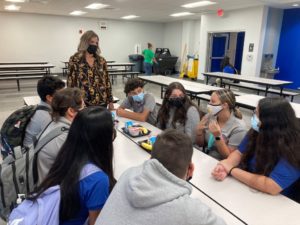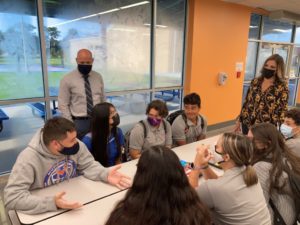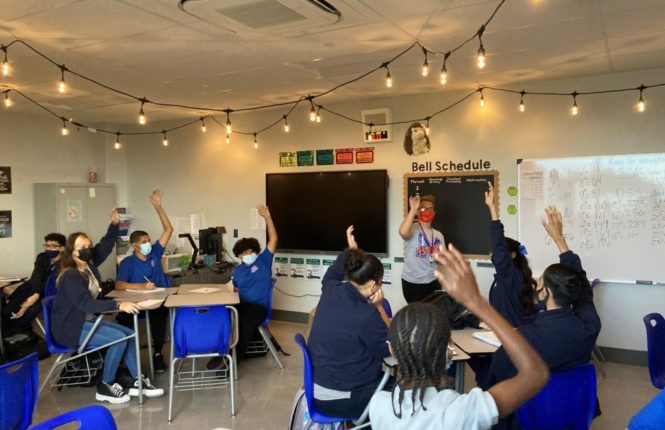Opportunity, diversity, and a new hot spot for education choice
reimaginED | By Ron Matus | September 13, 2021
KISSIMMEE, Fla. – When it came time to find an elementary school for her daughter Amanda, Maria Jimenez researched several options in Osceola County before choosing Mater Brighton Lakes Academy, a charter school with a strong academic reputation and a vibe that “felt like home.” A friend with a daughter the same age as Amanda chose a different school. But a year later, when the friend saw Amanda and her classmates surging academically, the friend switched to the charter school, too.
“Parents are talking. Parents are comparing,” said Jimenez, a stay-at-home mom. “Parents are doing whatever’s best for their children.”
Booming Osceola County, just south of Orlando, is the latest hot spot for school choice in Florida.
Fueled by Puerto Rican transplants looking for better jobs and a better life, the population of Osceola has rocketed 70% in the past 10 years and more than doubled in the past 20, to nearly 400,000 people. As fate would have it, that search for economic opportunity coincides with Florida’s expansion of educational opportunity.
“Education is very important to the Puerto Rican community,” said Jimenez, who is of Puerto Rican descent and now has two children – Amanda, in fifth grade, and Jayden, in first – attending Mater Brighton Lakes. “Why are they choosing charter schools? Because they challenge students. You can tell the students are learning in a way that’s going to help them through their entire life.”
Osceola now has the highest rate of students in charter schools among the big urban counties in Florida, recently surpassing Miami-Dade. The 25 charter schools in this corner of Florida, once better known for cowboys than Boricuas, enroll more than 15,000 students. That’s 22% of the county’s public school enrollment, and up 41% from five years ago.

The trend lines belie the myths. The primary beneficiaries of choice are Black and Hispanic students from working-class families, like those who left Puerto Rico in the wake of the Great Recession and Hurricane Maria. And if choice is an exclusive tool of the political right, as choice opponents often suggest, somebody forgot to tell their parents. In Osceola, one of Florida’s fastest-growing “blue” counties, Democrats now outnumber Republicans 2-to-1.
Hispanic parents are especially enthusiastic about choice.
Florida’s public-school enrollment is 35% Hispanic. Its charter school enrollment is 44% Hispanic.
Hispanic students in Florida also make up a disproportionate share of students using private school choice scholarships and education savings accounts.
In Osceola last year, more than 3,000 Hispanic students used the Florida Tax Credit Scholarship for lower-income families. More than 350 others used education savings accounts for students with special needs. Those programs are administered by Step Up For Students, the nonprofit that hosts this blog.
Osceola County School Board Member Jon Arguello is not surprised.
Charter schools have helped the district accommodate growth. And relations between the district and charter schools tend to be good, which is not the case everywhere in Florida.
But parents – especially Hispanic parents, Arguello said – also like what they see in charter schools.
“Charter schools have a more diverse workforce and smaller environments which suit Hispanic families,” said Arguello, who supports choice, including non-district options. “Hispanics, culturally, don’t like to complain about educators or medical professionals, they just quietly leave.”
Fifteen charter schools have opened in Osceola in the past 10 years. All around them, pastures and orange groves continue to sprout homes at a wild pace. The new subdivisions with palm-lined entrances are impossible to miss. So are the new churches with Spanish names, and the restaurants selling mofongo and tres leches cake.
Mater Brighton Lakes and three others in the Mater network are among the new schools.
At 12 of those schools, students of color are 75% or more of total enrollment.
At Mater Brighton Lakes, it’s 92%.
The Mater network decided to expand its Brighton Lakes location three years ago, so the same campus is now also home to Mater Academy Preparatory High School. Together, the schools enroll 1,500 students.
Serviced by the charter school support organization Academica, the Mater network has a long track record of academic accomplishment, and long standing among parents as responsive.
“We are smaller. You can make a better connection. And you can have multiple children all in one school, from elementary school to high school,” said Carmen Cangemi, a former teacher in the Miami-Dade school district who is now principal of the two Mater schools. “Parents love that opportunity.”
Many students attended other schools before coming to Mater.
Blanca Pagan, a 10th grader, described her former school as “disorganized,” with pervasive fighting and bullying. Her parents complained, she said, but nothing changed. At Mater, “I didn’t feel left out, and I became more comfortable,” she said. “Academically, it’s amazing.”

Naomy Sepulveda, also a 10th grader, said the unruly behavior of other students at her prior school upset her, but she stayed quiet because she didn’t think speaking out would make a difference. Once she got to Mater, “people listened to what I had to say,” she said. “My voice mattered.”
Mater’s high school might be smaller, but it still offers a broad array of advanced classes, electives, sports and clubs, and perhaps, given its size, even more leadership opportunities. For many parents, it’s a winning combination.
Gwyneth Williams transferred her daughter Andrea to Mater in sixth grade.
A contract negotiator for TECO, Williams said she wanted a school with a tight-knit, family atmosphere and high expectations. Now in 11th grade, Andrea has completed multiple dual enrollment courses and is on track to graduate with both a high school diploma and an associate degree.
“The teachers see the potential and the students are rising to it,” Williams said.
Arguello, the school board member, said charter schools have shown what’s possible with a model that’s more flexible and adaptable.
Going forward, he said, the district and charter sector should be partners in developing options that better serve the community.
“Hopefully the competition gets us there,” he said.






